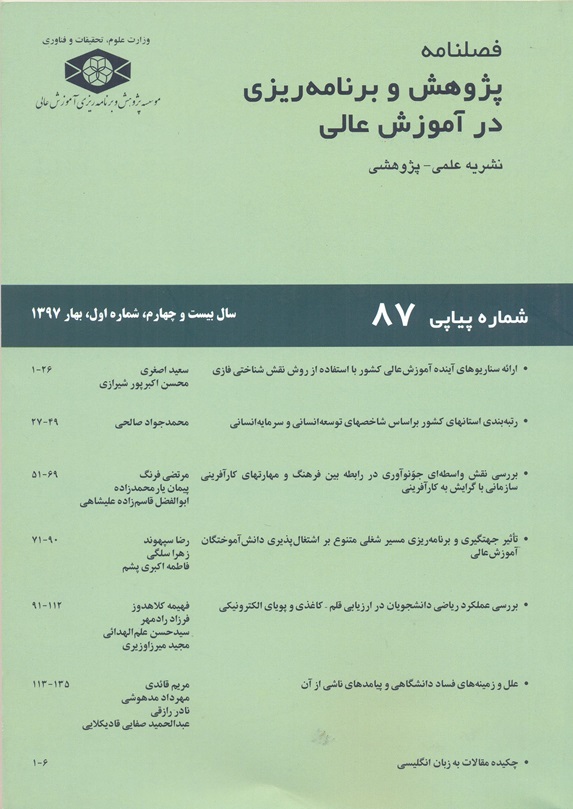رتبه بندی استان های کشور بر اساس شاخص های توسعه انسانی و سرمایه انسانی
نویسنده
استادیار گروه اقتصاد آموزشعالی و بررسیهای نیروی انسانی، مؤسسه پژوهش و برنامهریزی آموزش عالی
چکیده
شاخص توسعه انسانی متشکل از سه نشانگر امید به زندگی، آموزش و درآمد سرانه است؛ یعنی شاخصی که میزان موفقیت کشورها یا مناطق را در سه معیار زندگی طولانی و سالم، دسترسی به دانش و معرفت و زندگی مناسب نشان میدهد. همچنین سرمایه انسانی میزان دانش نهادینه شده در انسانها را به منظور رشد و توسعه کشورها و به نوعی همان معیارهای توسعه انسانی را نشان می دهد. بر این اساس، هدف از این مطالعه رتبهبندی استانهای کشور بر اساس دو شاخص یادشده و مقایسه آنها با هم بود. روش پژوهش ریاضی و کمّی بود که برای محاسبه شاخص توسعه انسانی از روش تاکسونومی عددی و برای محاسبه سرمایه انسانی از روش مبتنی بر درآمد استفاده شد. نتایج پژوهش نشان داد که استانهای کشور در تکتک شاخصهای سازنده توسعه انسانی با هم متفاوت و بنابراین، رتبه استانها در شاخص ترکیبی توسعه انسانی ناشی از معیاری است که وزن بیشتری در آن استان دارد. در مقام مقایسه با شاخص سرمایه انسانی نیز همگرایی معناداری بین این دو شاخص مشاهده نشد، اگرچه در نزدیک به نیمی از استانها رتبه شاخص توسعه انسانی و سرمایه انسانی به هم نزدیک بودند و در بسیاری از آنها نیز تفاوت چشمگیری دیده می شد.
کلیدواژهها
عنوان مقاله [English]
Ranking Iran's Provinces Based on Human Development and Human Capital Indices
نویسنده [English]
- Mohammad Javad Salehi
Assistant Professor, Department of Economics of Higher Education and Manpower, Institute for Research and Planning in Higher Education, Tehran, Iran.
چکیده [English]
Human Development Index consisted of three indices: life expectancy, education and per capita income. This index shows the improvement of countries in three dimensions: a long and healthy life, being knowledgeable and have a decent standard of living. In addition, human capital shows the knowledge embedded in humans for economic growth and development of nations and in some way the same human development index. The aim of this study was ranking of Iran provinces based on two mentioned indices and comparing the two with each other. The research method was mathematical and quantitative. The numerical taxonomy was used to calculate the human development index, and the income-based method was used to calculate human capital. The finding showed that the provinces of the country differ in each of the of human development provinces. Therefore, the rank of provinces in the combined human development index is due to a criterion that has more weight in that province. There was no significant relation between human capital and human development indices. Although, almost in half of the provinces the human development index and human capital rank were closed, there were also significant differences in many of them.
کلیدواژهها [English]
- human development
- human capital
- Ranking
- province
2. Salehi, M. (2013). Providing a model for measuring human capital and estimating it in Iran. Research Project, Higher Education Research and Planning Institute (in Persian).
3. Teyfouri, V., & Akbari, S. (2013). Investigating the indicator of human capital development in Iran with emphasis on Guilan province, census of population and housing. Vice President of Strategic Planning and Control Deputy (in Persian).
4. Ebadi, J., & Salehi, M. (2010). The effect of human capital inequality on men and women on the life expectancy. Quarterly Journal of Research and Planning in Higher Education, 16(2), 81-98 (in Persian).
5. Iran Statistics Center, National Demographic satin of Iran (Multiple years) Annual Report (in Persian).
6. Iran Statistics Center, The results of regional accounts of the provinces of the country (Multiple years) Annual Report (in Persian).
7. Iran Statistics Center, Results of Population and Housing Census (Multiple years) Annual Report (in Persian).
8. Mollaie, M. (2007). Comparison of the degree of development of service sector and social welfare of Iranian provinces during 1994-1997. Quarterly Journal of Social Welfare, No. 24 (in Persian).
9. Ministry of Health and Medical Education (2013). Annual Report (in Persian).
10. Arrow, K.J., Dasgupta, P., Goulder, L.H., Mumford, K.J., & Oleson, K. (2012). Sustainability and the measurement of wealth: Further reflections. Environment and Development Economics, Cambridge University Press, 18(4), 504-516.
11. Klenow, P., & Rodriguez- Clare, A. (1997). The neoclassical revival in growth economics: Has it gone too far?. NBER Macroeconomics Annual, Vol. 12.
12. Oxley, L., Le, T., & Gibson, J. (2010). Measuring human capital: Alternative methods and international evidence. Journal of Economic Surveys, 24(2).
 فصلنامه پژوهش و برنامه ریزی در آموزش عالی
فصلنامه پژوهش و برنامه ریزی در آموزش عالی
